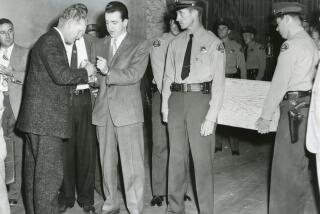Putting animals, bugs and corpses on trial sounds weird, but what’s a body to do?
- Share via
Pit bulls are in bad repute. The recent rash of attacks on human beings, some of them children, has understandably horrified the public and turned it against this formidable pet.
There is no doubt that legally the owners of pit bulls must be held accountable for their depredations. In our compassion for dumb animals we can’t punish them for acting out their instincts or for doing what they have been trained to do. If a dog can be obscene on the front lawn with impunity, how can we prosecute him for being savage on the sidewalk?
Thus, when a pit bull runs out the front door of a house and attacks an animal control officer, the dog’s owner must be held responsible and punished according to the law.
I have some sympathy with people who own pit bulls and love them. I have written here before about the pit bull my family had when I was a small boy in Fresno. He was brave and pugnacious; he cowed every other dog in the neighborhood but a courageous Airedale; they would have killed each other had we not broken up their fights with water hoses.
Buddy also liked to terrify visitors, including the postman. But whenever we saw the postman coming we put Buddy in the basement, from where he peered out a small window in the foundation, barking ferociously. He soon learned, when he saw the postman coming, to run into the basement by himself. I suspect that most pit bulls are at least as smart as Buddy was, and could also be taught self-restraint, if their owners cared to teach them. Alas, it is obvious that many pit bull owners keep them because they are aggressive, and don’t want them tamed.
Since we do not prosecute animals for violations of our statutes, any more than we hold them to our standards of morality, we don’t know quite how to deal with rogue dogs. Should they be put to death? Should their owners go to jail? The latter is the only humane solution.
It was not always so. By coincidence, Jim Moore, now living in Cambridge, England, has sent me a pertinent column from the Guardian by Nicholas Humphrey. It is about the historic custom of bringing errant animals to trial.
Humphrey recalls that in 1522 some rats were ordered to appear before the court of Autun, France, on charges that they had “feloniously eaten up and wantonly destroyed” the local barley crop.
When the rats failed to show up, their clever defense attorney, one Bartholemew Chassenee, argued that they had not been properly served, and that in any case they had been too frightened to come to court, because of the town’s cats. The judge, being unable to force the townspeople to keep their cats indoors, was obliged to dismiss the charges.
Quoting “The Criminal Prosecution and Capital Punishment of Animals,” written 80 years ago by E. P. Evans and recently republished (Faber & Faber), Humphrey reports that from the Middle Ages until the 19th Century, dogs, pigs, rats and even flies and caterpillars were brought to court on charges ranging from murder to obscenity.
“The trials were conducted with full ceremony, witnesses were called, arguments heard on both sides, and in many cases the animal was given legal aid, provided at the taxpayers’ expense. . . .”
The punishment of convicted animals could be dire. In 1386, in Falaise, Normandy, a pig convicted of maiming a baby was sentenced to be “mangled and maimed,” then dressed in a jacket and breeches and hanged on a gallows in the market square.
But mercy could be shown. Six piglets accused of murdering a child were let off on the grounds that they were under age. A colony of weevils accused of damaging a vineyard were deemed to have been exercising their natural right to eat.
Inanimate objects could also be brought to justice. In Greece, a statue that fell on a man and killed him was convicted of murder and sentenced to be thrown into the sea. In Russia, a bell that tolled too exuberantly on the assassination of a prince was charged with treason and exiled to Siberia.
Sometimes the bodies of criminals already dead were brought to trial. On his accession in 896, Pope Stephen VI accused his predecessor, Formosus, of sacrilege. The dead Pope’s body was exhumed, dressed in papal robes, and placed on a throne in St. Peter’s. A deacon was assigned to defend him. On his conviction his body was stripped and thrown into the Tiber.
Evans concluded that the purpose of these prosecutions was psychological. The times were cruel, violent, corrupt and uncertain. People looked to the courts to provide an explanation for the calamities that befell them.
Curiously, Humphrey finds a contemporary parallel to these prosecutions in the prosecution of the Nazi war criminal Klaus Barbie. He notes that Barbie’s lawyer presented a defense as outrageous and disingenuous as those presented in behalf of animals in medieval times.
“Human nature abhors a vacuum,” Humphrey observes. “Aren’t we seeing again nothing other than people’s need to make sense of nonsensical events--to close the book on a chapter of otherwise inexplicable calamity. Barbie’s living presence in the courtroom has almost no significance. If he were dead, his corpse would serve the role of the defendant just as well. At the end of it, Barbie’s body will metaphorically be thrown into the Rhone. We shall all feel curiously relieved. . . .”
Maybe we should have tried the body of Lee Harvey Oswald.
More to Read
Sign up for Essential California
The most important California stories and recommendations in your inbox every morning.
You may occasionally receive promotional content from the Los Angeles Times.













